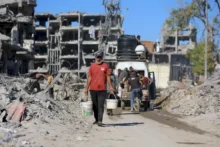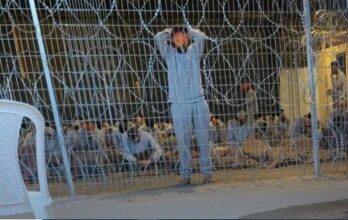شبكة الخامسة للأنباء - غزة

Displacement Under Fire .. Special Report By: Sahar Dahliz
Displacement in the Gaza Strip is not merely a geographic move from one place to another; it is a forced uprooting under bombardment, and a coerced rush into the unknown. Thousands of families are compelled daily to leave their destroyed homes, laden with fear and the bitterness of loss, searching for shelter that may offer them no safety.
The reality of displacement is a daily journey repeated under fire, unlike any other human experience. It is not only an escape from death, but a direct collision with homelessness, hunger, and the collapse of life’s essentials. In the absence of any international protection or practical solutions, the plight of the displaced in Gaza has become a stark emblem of an open-ended catastrophe, worsening day by day amid the world’s silence and deliberate neglect of civilian suffering.
Exorbitant costs of displacement.. a burden beyond bearing
With the complete collapse of infrastructure and the halt of most forms of support, the journey of displacement is no longer merely a difficult decision. It has become a financial challenge beyond the reach of most Gaza residents. Field estimates indicate that the cost of displacement for a single family may exceed $3,000. An amount far beyond the means of the vast majority of besieged families.
Cost details:
– Transport: $800 to $1,000, depending on distance, number of people and amount of luggage.
– Tent: up to $700, despite offering no basic elements of human dignity.
– Renting land: costs range between $400 and $600 per month for a small plot used as a temporary refuge.
– Basic supplies (shelters, wood, simple tools): nearly an additional $1,000.
Faced with these staggering figures, many families find themselves unable to flee — not because the danger is distant, but because the costs of escaping death have exceeded their capacity to stay alive. Thus they are left with two bitter choices: remain in homes threatened by bombardment, or embark on a displacement journey they cannot bear physically or financially.
Voices from the heart of the tragedy
Displacement in Gaza is no longer merely an emergency relocation; it has become an open-ended ordeal, marked by steep costs and a tragic living reality, with no shelter and with bombardment continuing even in areas described as “safe.”
Abu Mohammad, the head of a displaced family from the northern sector, says: “I left my house and could only take a few clothes for the children. I paid $900 just for a vehicle to move me and my family to Nuseirat. When we arrived, there was neither a tent nor a place; we slept on the ground.”
Umm Alaa recounts another side of the suffering: “The tent I bought for $700 does not protect us from the heat or the rain. Every day I tell myself: staying in the ruined house would have been easier than living like this in front of my children.”
The south can no longer accommodate the displaced
Local data indicate that more than one and a half million displaced persons have crowded into the southern and central parts of the Strip since the start of the assault. This has exceeded these areas’ capacity to absorb them. Public squares and schools are completely full, and roads have turned into makeshift camps. There is no longer space to pitch a new tent.
And while these areas are supposed to be refuges, repeated targeting has reached even the so-called “safe areas.” This has left the displaced trapped in a cycle of continuous fear, without real shelter, protection, or the slightest sense of safety.
A compound tragedy
The suffering of the displaced in the Gaza Strip is not limited to the loss of shelter; it extends to all aspects of life amid a total collapse of infrastructure and the absence of the most basic means of survival.
The United Nations and humanitarian organizations have repeatedly warned that the conditions of the displaced in Gaza have reached the level of a comprehensive catastrophe, amid rising fears of further deterioration if the assault continues.
They added: “Food insecurity, lack of clean water, a severe shortage of medicines, and the collapse of the health system — all are factors that turn displacement into a daily battle for survival.”
A relief activist told Al-Khamisa Network: “Displacement in Gaza is no longer a choice but a daily struggle to stay alive. Families either face bombardment in their homes, or face hunger, disease and homelessness in tents. All roads lead to tragedy.”
Displacement with no horizon… and no hope
With continued Israeli shelling and shrinking “safe” spaces, displaced families have no clear horizon.
There are not enough places to host them, no guarantees of protection, and no financial capacity to endure a new displacement if current refuge areas are bombed again, as has happened repeatedly.
UN reports say more than 1.9 million people have been internally displaced within the Gaza Strip, representing more than 85% of its population.
In this context, displacement becomes another face of the slow annihilation Palestinians are being subjected to. People are forced to abandon their homes, savings and stability, living under a roof of fear, hunger and homelessness amid suspicious international silence. This reality not only reveals the depth of the humanitarian tragedy in Gaza, but also highlights the absence of minimal protection and international support for civilians, in the midst of a compound catastrophe that exceeds the limits of endurance.




